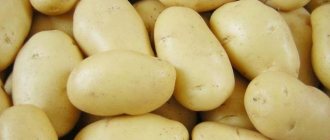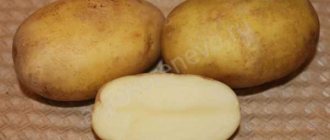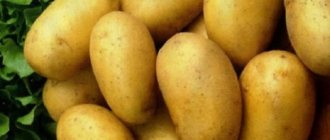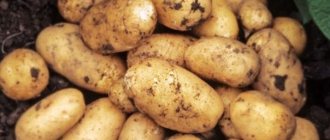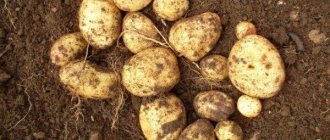Description of the variety and its origin
Molly potatoes are an ultra-early variety bred by breeders of the German company Norika Nordring-Kartoffelzucht-Und Vermehrungs-GmbH. Culture was included in the State Register of Russia in 2007. The sales patent is owned by Agro LLC.
The variety has received approval for cultivation in the Central region, including Bryansk, Moscow, Kaluga, Vladimir, Ryazan, Ivanovo, Tula, and Smolensk regions.
Pictured are Molly's potatoes.
The table shows the distinctive features of the variety.
| Indicators | Characteristic |
| Ripening period | 55-65 days, first dig - in 40-45 days |
| Bush | Medium height, stem type, semi-erect to spreading |
| Number of tubers in a bush | 20-25 |
| Weight | 98-142 g |
| Form | Oval-round with small eyes |
| Coloring | The peel and pulp are yellow |
| Leaves | Medium to large in size, light green to green in color, with slight wavy edges |
| Corolla color | White |
| Starch content | 11,4-13,4% |
| Taste | Good (4 on a five-point scale) |
| Cooking class/group | A/B (light or medium crumbly) |
| Productivity | 171-308 c/ha |
| Marketability | 80-92% |
| Keeping quality | 82% |
| Purpose | Dining room |
| Sustainability | To golden nematode, cancer, Alternaria, fusarium, verticillium, common scab |
| Transportability | Average |
Chemical composition of the product
The table shows the complex of vitamins and minerals contained in 100 g of raw tubers.
| Substance | Content | Daily norm |
| Beta carotene | 0.001 mg | 5 mg |
| Vitamin B1 | 0.081 mg | 1.5 mg |
| Vitamin B2 | 0.032 mg | 1.8 mg |
| Vitamin B4 | 12.1 mg | 500 mg |
| Vitamin B5 | 0.295 mg | 5 mg |
| Vitamin B6 | 0.298 mg | 2 mg |
| Vitamin B9 | 15 mcg | 400 mcg |
| Vitamin C | 19.7 mg | 90 mg |
| Vitamin E | 0.01 mg | 15 mg |
| Vitamin K | 2 mcg | 120 mcg |
| Vitamin PP | 1.061 mg | 20 mg |
| Potassium | 425 mg | 2500 mg |
| Calcium | 12 mg | 1000 mg |
| Magnesium | 23 mg | 400 mg |
| Sodium | 6 mg | 1300 mg |
| Phosphorus | 57 mg | 800 mg |
| Iron | 0.81 mg | 18 mg |
| Manganese | 0.153 mg | 2 mg |
| Copper | 110 mcg | 1000 mcg |
| Selenium | 0.4 mcg | 55 mcg |
| Zinc | 0.3 mg | 12 mg |
What tubers grow
Gardeners like the ratio of ripening period:taste:yield. Characteristics of Molly root vegetables:
- tubers are smooth, slightly rough;
- oval shape, leveled;
- the weight of one tuber reaches 150 g;
- starch content - 15.3%;
- potato skin color is yellow;
- few ocelli, shallow location;
- when cut, the tuber has a light yellow or cream color;
- fine-grained structure;
- The pulp is medium crumbly.
The yield of the variety with proper care reaches 22 tons per hectare. Some gardeners harvest 36 kg/bush.
A distinctive feature of the Molly potato variety: the pulp changes color during heat treatment.
See also
Instructions for use of the drug Tabu for treatment against the Colorado potato beetleRead
Features of planting and growing
Molly potatoes are characterized by rapid growth of green mass with a small number of flowers. The crop is immune to drought, easily tolerates water shortages, but responds to moderate watering with an increase in yield.
The variety is suitable for growing on any type of soil after perennial grasses. In regions with cold climates, potatoes are grown under film.
Tuber preparation
Germinating tubers before planting is an optional procedure, but it significantly speeds up germination and protects against fungi and pests. Some farmers buy second- or third-generation varietal tubers from gardening stores.
For planting, select seeds weighing 50-70 g and soak them in a disinfecting solution of potassium permanganate, copper sulfate, and Fitosporin-M.
The day before planting, the tubers are treated with a growth stimulant (“Krezacin”, “Epin-Extra”, “Albit”, “Zircon”, “Immunocytofit”).
Soil requirements
Molly potatoes are not picky about the type of soil, but they show the best results when cultivated in light, nutritious soil. In the fall, the selected area is dug up, harrowed, loosened and fertilized with manure.
In spring they are sown with flax, lupine, rye, oats, and wheat. After 30 days, the grass is mowed and shallowly embedded in the soil. This enriches the soil with nitrogen and prevents the development of pathogenic microflora.
Dates, scheme and rules of planting
The timing of planting potatoes depends on the growing region. In the south, planting work is carried out at the end of April, in the north and in the middle zone - in the first and second ten days of May.
The optimal soil temperature is +10…+12°C. To protect against possible night frosts, the beds are covered with agrofibre.
The depth of planting tubers under a shovel is 5-10 cm. The gap between holes is 25-30 cm. The row spacing is 50-60 cm.
A handful of ash and superphosphate is added to each hole. To protect against wireworms, add onion peels; to repel the Colorado potato beetle, add a few peas or beans.
Care
The culture does not require a special approach to care. Agricultural technology is based on standard procedures: watering, loosening and weeding beds, hilling, fertilizing.
Despite being drought tolerant, Molly potatoes respond positively to moderate watering. To ensure a regular supply of water, drip irrigation is organized on the site. The bushes are watered manually once every 10 days.
Loosening and weeding have a beneficial effect on the health of the plant and its productivity, saturate the root system with oxygen, and facilitate the access of moisture. Weeds are removed as they appear, preventing them from taking root.
Hilling is carried out a week after planting, thereby providing protection from frost and promoting the growth of the root system. The procedure is repeated during the flowering period to stimulate tuber formation.
After the sprouts reach 12 cm in height, the bushes are fed with nitrogen, for example, a solution of chicken manure in a concentration of 1:15. During the flowering period, mineral root feeding is applied: 35 g of ammonium nitrate, 20 g of superphosphate, 10 g of potassium salt, 2 g of copper sulfate per 10 liters of water. For foliar feeding, take 25 g of urea and dissolve it in 10 liters of water. Consumption per bush - 0.5 l. They also use green fertilizers - an infusion of nettles with tomato tops: half a bucket of greens per 10 liters of water.
Planting potatoes in trenches
